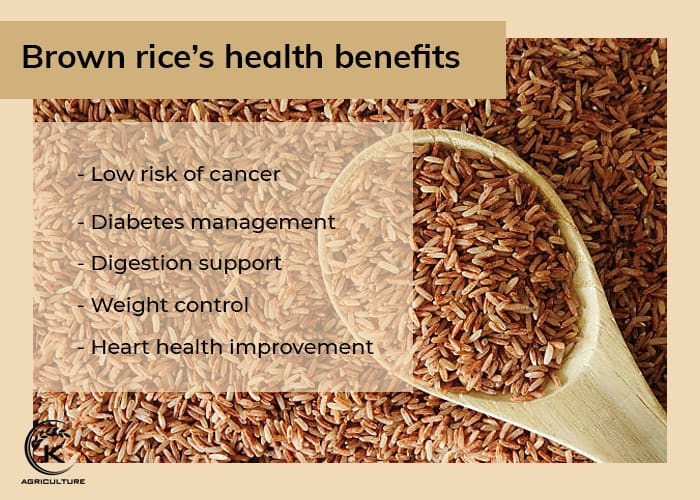Among various types of rice, the brown rice benefits stand out as it is packed with essential nutrients that support overall health and help improve many conditions. For this reason, brown rice has become a crucial ingredient in everyday meals.
Contents
- 1 What is brown rice?
- 2 Types of brown rice
- 3 Brown rice benefits for your health
- 4 How to preserve brown rice
- 5 FAQs
- 5.1 What are the key health benefits of brown rice?
- 5.2 How does brown rice support weight loss?
- 5.3 Is brown rice good for people with diabetes?
- 5.4 How does brown rice compare to white rice nutritionally?
- 5.5 Can brown rice help lower cholesterol?
- 5.6 Is brown rice gluten-free?
- 5.7 Can brown rice be part of a diet for people with food allergies or sensitivities?
- 6 Conclusion
What is brown rice?
Brown rice is often called a whole grain because it retains the bran layers and the germ. With the removal of the hull (the protective outer part), brown rice is less processed compared to white rice, which retains the only core part – endosperm.
Read more:
Brown rice is different from white rice
The color of brown rice results from the bran layers remaining after the process of hulling. The rice comes in a chewy texture and smells nutty after cooking.
Thanks to the minimal process, a rich source of nutrients such as vitamins and minerals remains in brown rice. In terms of nutrient profile, brown rice outperforms white rice in many categories when the former is higher in fiber, magnesium, vitamin B6, etc.
Overall, these qualities explain why brown rice benefits are highly valued in a balanced diet. It is widely recognized as a healthier alternative compared to refined rice.
According to The U.S Food and Drug Administration, a serving of brown rice contains
| Calories | 216 | Carbs | 44 g |
| Fiber | 3.5 g | Fat | 1.8 g |
| Protein | 5 g | Vitamin B1 | 12% of the RDI |
| Vitamin B3 | 15% of the RDI | Vitamin B6 | 14% of the RDI |
| Vitamin B5 | 6% of the RDI | Iron | 5% of the RDI |
| Magnesium | 21% of the RDI | Phosphorus | 16% of the RDI |
| Zinc | 8% of the RDI | Cooper | 10% of the RDI |
| Manganese | 88% of the RDI | Selenium | 27% of the RDI |
As mentioned in the table, by eating brown rice, people can intake many different types of vitamins such as B1, B3, B5, and B6. Moreover, a considerable amount of magnesium is included in the rice. Magnesium is good for the development of bone, the regulation of blood glucose, the healing of the skin, and nerve function.
Importantly, there are only 216 calories in a cup of brown rice. This fact makes brown rice suitable for people who want to control their weight and follow healthy diets.

Brown Rice
Types of brown rice
To better understand brown rice benefits, it is helpful to know that this grain comes in different types, categorized in several ways to meet diverse needs. Brown rice is classified into various types to meet diverse customer requirements. Basically, there are 3 ways to categorize brown rice.
Classification by length

Classification by length of organic brown rice
- Short grain brown rice
Short grain brown rice will become sticky after cooking, which is suitable for sambar, dal, or sushi. It requires only 25 minutes to cook this type of brown rice if it is soaked overnight.
- Medium grain brown rice
The texture of medium grain brown rice is tender and moist, making the rice mix well with soup or salad. For the best use, medium grain brown rice should be soaked in 4 hours, then it takes only 15 minutes to cook.
- Long grain brown rice
Long grain brown rice possesses a nutty flavor. It is the main ingredient in many dishes such as paellas and rice pilaf. The cooking time of long-grain brown rice is longer than the others, which is around 45 minutes.
Classification by color
- Light brown rice
Different from 3 given varieties that are classified based on the rice length, light brown rice is named by its color since half of the bran is removed during milling. This makes the rice less fiber and slightly nutty. Hence, it takes about 20 minutes to cook light brown rice.
Classification by type

Classification by type of organic brown rice
- Sweet brown rice
Sweet brown rice is usually short or medium-grain rice. When cooked, the rice becomes sticky due to the high starch content. The cooking time of sweet brown rice is about 35 minutes.
- Brown basmati rice
Normally, basmati brown rice has a long-grain shape. When it cooks up, the rice becomes dry and firm. Brown basmati rice is widely used to make pilafs and biryanis. It can be served after 22 minutes of cooking.
Brown rice benefits for your health
Due to its nutrient-dense content, research from the American Eurasian Journal of Agronomy highlights numerous brown rice benefits that contribute to better overall health.

Benefits of brown rice in reducing cancer risk
Among the many brown rice benefits, its impressive mineral profile plays a key role in protecting the body from harmful agents.
88% of a mineral called Manganese is contained in a cup of brown rice. This mineral contributes to the formation of superoxide dismutase. It is an antioxidant enzyme that is against free radicals – agents partially causing cancer.
Diabetes management
The glycemic index in brown rice is low, which helps maintain a stable level of blood sugar. The International Journal of Food Sciences and Nutrition shows that 32% of the risk of having Diabetes can be reduced by eating brown rice.
Digestion support
Adding brown rice to daily meals can help improve the human digestive system thanks to its high content of fiber. Bowel movement will be supported by the presence of fiber in brown rice; therefore, consumers will feel full for a long period of time.
Weight control
The glycemic index in brown rice is low, which is only 216 calories in a cup. As a result, brown rice is widely used by people who want to manage appropriate weight or to combat obesity.
Heart health improvement
Fiber and magnesium in brown rice are useful in preventing heart disease and stroke. Adding brown rice into daily meals can lower the risk of stroke by 12% and that of heart diseases by 22%.
Builds strong bones and muscles
This may surprise you, but one of the lesser-known brown rice benefits is its role as a good source of vegetarian protein. A single cup of cooked brown rice provides about 10% of the daily protein requirement, and you can also boost intake with brown rice protein powder.
Your body uses protein to:
- Boost energy
- Build and repair bones, muscles and tissues
- Curb hunger and maintain a healthy weight
- Grow healthy hair, nails and skin
- Protect your heart and brain
Safe for gluten-free diets
Brown rice is often a go-to carb for many gluten-free eaters. Similar to oatmeal, it is naturally free from gluten as long as it isn’t contaminated with gluten-containing substances.
One of the key brown rice benefits is that it provides plenty of fiber and essential B vitamins without the gluten, helping those on a gluten-free diet avoid nutritional gaps.
How to preserve brown rice

How to preserve brown rice
The shelf life of brown rice is quite short, around 6 months. Hence, it is important to store brown rice in the right way.
For uncooked brown rice, it is highly recommended to store it in airtight containers. This way will prevent the oil in the bran layers from oxygen exposure, which can spoil the quality of the rice. Then, these containers of brown rice should be put in a cool space without sunlight such as refrigerators.
For cooked brown rice, proper storage is important to maintain both quality and the brown rice benefits it offers. It can be kept in the refrigerator or freezer, and using freezer bags instead of containers helps save space. Remember to remove excess air from the bags before sealing.
FAQs
What are the key health benefits of brown rice?
Brown rice provides high amounts of dietary fiber, antioxidants, and essential minerals like magnesium and potassium, which can lower the risk of heart disease, diabetes, certain cancers, and support gut health.
How does brown rice support weight loss?
Thanks to its high fiber content, brown rice increases satiety, helping with portion control, reducing overall calorie intake, and supporting weight loss and maintenance.
Is brown rice good for people with diabetes?
Yes. Brown rice has a low glycemic index, meaning it helps stabilize blood sugar levels and reduces spikes after meals, which is beneficial for people with diabetes or those at risk of developing type 2 diabetes
How does brown rice compare to white rice nutritionally?
Brown rice retains its bran and germ layers, providing more fiber, B vitamins (such as B1, B3, B6, and B9), magnesium, and iron than white rice, which loses many nutrients during processing
Can brown rice help lower cholesterol?
The soluble fiber and plant compounds in brown rice can help lower LDL (“bad”) cholesterol, thus supporting cardiovascular health.
Is brown rice gluten-free?
Brown rice is naturally gluten-free, making it suitable for people with celiac disease or gluten intolerance.
Can brown rice be part of a diet for people with food allergies or sensitivities?
Yes, because brown rice is hypoallergenic and gluten-free, it’s a suitable carbohydrate for those with multiple food allergies or intolerances.
Conclusion
Brown rice is more than just a healthy alternative to white rice – it is a powerhouse of nutrients that support overall wellness. From providing fiber, vitamins, and minerals to offering vegetarian protein and being naturally gluten-free, the brown rice benefits are both diverse and long-lasting. Incorporating brown rice into daily meals not only enhances nutrition but also contributes to a balanced lifestyle. With its versatility and proven health advantages, brown rice truly deserves a place as a staple in modern diets.
K-Agriculture Factory is one of the leading suppliers of brown rice. If you want to buy this nutritious food with high quality at a reasonable price, please contact us via the website of K-Agriculture or WhatsApp +84855555694 (Ms. Evelyn).

K-Agriculture





Please Post Your Comments & Reviews